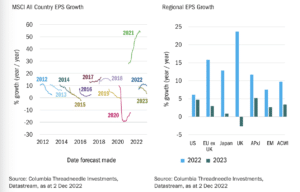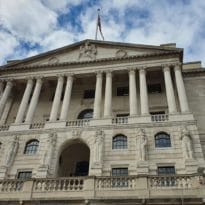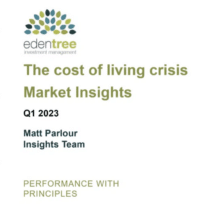Sponsored article
To understand what may happen in 2023 we need first to analyse what happened in 2022, says Steven Bell, chief economist, EMEA, Columbia Threadneedle Investments.
Those who cannot remember the past are condemned to repeat it.
Before we look forward to recession and recovery in 2023, we need to review this year. Without knowing where markets and economies have got to, it is difficult to forecast the next move. That seems especially pertinent after this year when expectations have been continually side-swiped.
A review of asset returns up to the end of November, shows a dismal picture. The impact of war, energy crisis and inflation, as well as sharp hikes in interest rates, are clearly visible. Practically everything went down, including poor returns from inflation hedges like UK index-linked gilts, US TIPS and gold. Natural gas went literally off the scale, while oil was up more modestly. Latin America was the best performing equity region, led by Brazil, led by Petrobras, on the back of oil. In the same way, the UK outperformed amongst developed markets. This is the worse S&P performance in a Fed hiking cycle – interestingly the, now, second worst was 1973.
I also need to review my own forecasts from last year, rather than simply blaming unforeseen events. I, happily, was correct about the end of Covid’s economic impact in 2022 (except China missed that memo), and I highlighted the inflation risks, even before the energy crisis, but the Fed missed that memo. The result was that a later and sharper cycle of interest rate hikes triggered fears of recession and meant that I was wrong about equities outperforming bonds, as both did equally poorly, with a few exceptions highlighted above.
Asset performance 2022
Inflation is the key issue – but the solutions are different across the Atlantic
Inflation was a problem before the energy crisis. Central banks hesitated to slam on the monetary brakes in case the release of economies from Covid lockdowns was another false dawn. This is most clearly seen in the energy self-sufficient US economy, where the vast majority of current inflation is nothing to do with energy prices.
However, there’s more to it than a central bank mistake. Because, around the middle of the year, the US economy was clearly slowing down, heading for a soft-landing as interest rates ticked up. At which point the still-confident US consumer reached for the ‘covid piggy-bank’ and went on a last splurge that left the Fed and markets struggling to catch up.
That’s why, with unemployment still extremely low and wage growth high, we are cautious about predicting the end of this US economic and interest rate cycle until we can see clear signs of a recession. We think that the Fed shares these concerns, both because of a pragmatic acceptance of limits on accurate forecasting, but also a belief that cutting interest rates too early was key to entrenching inflation in the 1970s. However, outside inflation we see little signs of financial imbalances that might create lingering problems, so a US recession need not be deep or prolonged.
Inflation US, EZ and UK: US core higher, food and energy lower
The energy crisis in Europe and the UK should be self-correcting
The coming recession in Europe and UK should cut energy consumption and extinguish other sources of inflation. Therefore, economic recovery can resume once energy prices fall in 2023. Governments are acting to cushion the consumer and economy from the worst of the squeeze, but also, ideally, encouraged reduced consumption and a switch to alternative sources, which means that energy prices can fall and the economy can recover sooner. We should continue to hope for a warm, wet and windy winter that cuts demand and boosts supply from hydro and wind power generation.
We can already see the impacts in the UK, with the all-important house prices falling. While they are still ahead on the year, they are already lagging inflation and we expect to see further falls.
This leaves less pressure on the European Central Bank and Bank of England to fight inflation by aggressively hiking interest rates. Though the discipline of an independent central bank will help give confidence to the process in the face of severe political pressures, as we saw in the short-lived Truss government. It’s amazing that markets seem to have forgiven the UK, let’s hope that we never do it again.
House prices already falling on some measures
The market keeps trying to rally, but the Fed waits for data
Markets have rallied again from November, with the size of the latest shift down in US real yields only obscured by the scale of changes already seen in 2022. Market forecasts seem a lot more realistic than during the mid-year rally, at least in terms of interest rates. Valuations, for both equities and bonds are more attractive after this year’s falls. However, analysts are still forecasting earnings growth for equities in 2023, while we expect a 15% fall in a mild recession.
There is plenty of scope for short-term factors to distract from real turning points. Those ‘covid piggy-banks’ could look pretty tempting around Christmas, so another boost in consumer spending that postpones the recession’s start by another quarter should not be discounted.
We prefer, like the Fed, to wait for the data. That suggests that the current rally is part of a continuing bear market, rather than marking a turning point. We would be cautious to pre-empt recovery before we have had a recession. That suggests that the end of the next quarter, after we are past the depths of winter and hopefully recession, would be a more appropriate time to look for turning points.
Analysts’ EPS estimates for 2023 look too high
Past performance should not be seen as an indication of future performance. The value of investments and any income derived from them can go down as well as up as a result of market or currency movements and investors may not get back the original amount invested. Screening out sectors or companies may result in less diversification and hence more volatility in investment values.









































